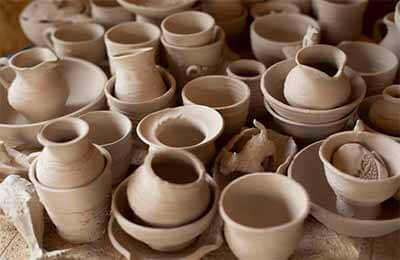意大利陶瓷精粹惊艳浙江
时间:2022-06-22 02:55:24

一朵奇葩在异域绽放,那是“土与火”的世界舞蹈。
“千年马约里卡精粹――意大利法恩扎国际陶瓷博物馆典藏”展览日前在浙江博物馆举行。此展是在中国举办的首次大规模、系统展示意大利马约里卡陶艺的历史发展、艺术内涵及工艺变革的专题展。141件(组)意大利陶艺珍品远渡重洋来到瓷器故乡,向中国观众展示“一带一路”上意大利陶瓷的精粹与传奇。
法恩扎国际陶瓷博物馆――目前世界上最大的陶瓷博物馆
法恩扎是意大利北部一个具有丰富历史文化遗产的小城,早在中世纪这里就制作陶器。公元14世纪当被泛称马约里卡的锡釉陶从西班牙传入意大利时,恰逢文艺复兴运动蓬勃兴起。悠久的历史文化积淀为马约里卡陶艺发展提供了重要创作源泉,并使其薪火相传、享誉当今世界的“一带一路”。
马约里卡国际陶瓷博物馆馆长Claudia Casali说,法恩扎国际陶瓷博物馆是目前世界上最大的专项收藏陶瓷器的博物馆。它成立于1908年,自诞生之日起,这个博物馆就拥有一种面向世界的胸怀。这次为中国展览精选的141件(组)藏品,就是来自法恩扎国际陶瓷博物馆的馆藏精品,反映了意大利从文艺复兴到20世纪的陶艺发展史的特色。
1944年,法恩扎遭盟轰炸。国际陶瓷博物馆亦未能幸免,馆舍及藏品毁于一旦。战后,法恩扎国际陶瓷博物馆的创始人葛塔诺・巴拉尔迪尼先生四处奔走,呼吁各界捐赠陶瓷艺术品来弥补战火中的损失。大批重要捐赠源源而来,博物馆浴火重生。特别是巴勃罗・毕加索的慷慨之举流芳史册。他不但捐赠了自己的作品,而且还吁请其他艺术家共襄盛举。
法恩扎国际陶瓷博物馆于1949年重新开放。
浙江工商大学的一位老教授正在向他的年轻的硕士生讲授法恩扎国际陶瓷博物馆的不寻常经历。他说除收藏之外,这家国际陶瓷博物馆还通过拥有7万多卷藏书的著名专项图书馆和从1913年开始出版的“法恩扎”陶瓷学术期刊,支持各类研究活动。
经过多年的发展,国际陶瓷博物馆规模日益壮大,增添了多个展馆和部门,展厅面积超过了1.6万平方米。目前,馆藏文物多达5.5万多件,囊括了从古代文明到当代文化艺术的所有历史时期和地域。永久性展厅的陈设布置经常变换,展览立意和陈列不断创新,参观者每次观看都能对陶瓷艺术有新的感受。
自1938年来,国际陶瓷博物馆一直举办“法恩扎当代陶瓷艺术大奖”比赛。2011年,法恩扎国际陶瓷博物馆作为世界陶瓷文化的代表得到了联合国教科文组织的表彰,并被列入“古迹和平文化遗产”的保存所在地
“一带一路”上的意大利陶瓷精粹卓越、风格独特
在文艺复兴新的历史时期,锡釉陶器的技艺在意大利得到了炉火纯青的发挥,马约里卡陶瓷开始闻名世界。
法恩扎生产的锡釉陶,有种叫做“相爱容器”的陶瓷器上面往往绘有理想中的美貌女子像,以此祝福相爱的人们婚姻幸福、白头偕老。展出的一件“执壶”陶壶即为典型产品,上面绘有一位年轻女性侧面头像,她戴着当时流行的头巾,穿着一件长袍,领口宽大并饰有丝带。蓝色背景中写着文字“MARIA B”,B意为“美丽”。
产自蒙特卢波的锡釉陶器“盘”,是17世纪初期热销的“小丑”系列题材中的一件。受喜剧人物启发,蒙特卢波陶工们创造了一种具有自由幽默精神的装饰风格,其画风自然、色彩丰富而活泼。此盘以浅黄色作背景,呈现了一个肩扛斧枪、腰佩短剑,穿着特定制服的男人形象。
17世纪末的锡釉陶“盘”产自拉泰尔扎。这件作品的灵感来自安尼巴莱・卡拉奇的著名作品《吃豆子的人》。高足盘画面中的男人坐在桌前,手拿大碗大快朵颐地吃意面;他背后有两位小天使手拿着勺子和叉子正在争吵。卷发的小天使穿着新颖的斗篷。画面布局充满对贪婪的资本罪恶的讽刺。
作为意大利陶瓷名窑的代表作,它们器型丰富、色彩斑斓,专为满足特定人群手工烧制。18世纪末至20世纪,这些名窑陶瓷器在意大利各地区独树一帜,尤其是南部意大利作坊生产的形式各异的器皿,有细颈瓶、油灯、盐钵、哨子及其他物品,创造性地采用了拟人化动物造型。
展厅展出的有些执壶做成怪兽或人物的样子,据说放在房门上,可以驱赶恶魔,保护家园。雕刻着纹饰和彩釉的那款鱼形“水壶”,壶身流淌着铜绿和铁黄两种彩釉,吸引着不少观众观赏。
多梅尼科・巴卡里尼是一名出色的艺术家,擅长油画、雕塑、素描和雕刻。他好学爱问,对器物外形和风格进行创新。他虽然英年早逝,却创作了大量的陶瓷作品蓝本,使当地厂商得以据此生产。此次展出的这件“花瓶”,从衣裳布料的线条和女子优雅的仪态可见这位艺术家的作品呈现出自由风格。
在林林总总的展品中,有一件策展人特别摧荐的蓝彩白釉陶大圆盘《折磨人的农牧神的脸》,中间是一张典型的毕加索笔下的脸,正出自这位世界绘画大师之手。
在很多人的印象中,毕加索只是一位享誉全球的大画家,但其实他的雕塑和陶瓷作品也同样出彩。他的陶瓷艺术借鉴古希腊罗马绘画,通过现代的装饰图案使表现力更为强烈。他的陶瓷器逐渐蜕去器皿功能而成为雕塑,影响着艺术家们开始在陶瓷上融入现代前卫艺术。
这件瓷盘完成于1956年。当时,在法国南部的瓦洛里斯,毕加索有机会接触拉米艾陶瓷厂,这满足了他对陶瓷的好奇,并激发了创作灵感。1947年夏天起毕加索开始探索陶艺,他把不同的形状和纹饰交替整合,并在绘画中融入黏土雕塑手法,创作出近乎幻觉的效果。毕加索的陶艺作品受希腊艺术和古典艺术的影响,也和神话故事有关,同时吸取洞窟壁画工艺,因此兼有前哥伦布时期艺术风格,这是对伟大的远古陶瓷文明的一种致敬。
东风西渐中的马约里卡陶瓷创新与发展
随着东西方文化交流的不断扩大,明清时期中国的瓷器通过海路远销西方,特别是青花瓷器普遍受到各国人们的喜爱。17世纪至18世纪,在东风西渐影响下的马约里卡陶瓷艺术和工艺中经常模仿中国明代瓷器,形成一种具有东方色彩的新的风尚,产品表现出浓郁的东方趣味。
公元l6世纪20年代,一些意大利陶工迁居荷兰,开始了荷兰的锡釉陶生产,并以仿制中国宜兴陶器为主。17世纪初,荷兰的陶器生产集中在德福特,其产品成为德福特陶。后来,荷兰东印度公司大量输入中国陶瓷器,陶器的装饰转向模仿中国的青花瓷而摒弃了意大利的装饰风格。
欧洲艺人制作了自己的“中国风”瓷器,纹样五花八门且带有异国情调,包括外国花朵、宝塔、微小的东方人物――均被意大利各地陶瓷厂以自己的方式演绎。同时出现的还有“欧洲风”,如贝兰式、洛可可式、垂纬状等纹饰,以及意大利喜剧人物、巴洛克风组合,还有各种各样写实的花朵图案。
展厅上一款“油灯”作品是20世纪中期的陶器实用器。西西里岛得天独厚的陶土资源为其丰富的陶器生产提供了有利条件,这些产品包括造型新奇的油灯,其中以人物形象和骑马人物油灯在当地最受欢迎。
16世纪下半叶法恩扎的陶工们在生产上进行重大改革,当时除了色彩斑斓的人物故事画陶器(该品种在16世纪中期达到顶峰),也出现了以优雅的风格、新颖多样的外形和浅色纹样为特点的“白陶”品种,掀起了颜色浅淡、形制简美的“简约风”。
时至今日,意大利法恩扎马约里卡陶瓷在世界艺术史上仍然具有重要影响。
中国和意大利同为世界文明古国,两千多年的古代“丝绸之路”架起连接东西方文明的桥梁。公元11世o后,随着海上贸易逐步扩大,特别是15至17世纪大航海时代,中意两国贸易日趋频繁,来自中国的瓷器对意大利乃至整个欧洲产生了重要影响。此次享有盛誉的意大利法恩扎国际陶瓷博物馆珍藏首次来到东方瓷器故乡,铺陈交融图景,为中意两国文化交流和“一带一路”建设续写了新的篇章。
‘The Best of Italian Ceramics: Majolica Pottery’ C Select Collections from the International Museum of Ceramics in Faenza, held in Zhejiang Museum in Hangzhou, is the first one held in China to display the ceramics industry and fine pottery arts of Italy. Visitors could tell from the 141 treasures representing the glory of the ‘Majolica Pottery’ tradition of Italy a magnificent chapter written by Italy in the ‘Belt and Road’ landscape.
Faenza is an Italian city of rich history and culture, situated in northern Italy. It is noted for its manufacture of majolica-ware glazed earthenware pottery, known from the name of the town as faience. The city flourished considerably as a result of its agricultural propensities and the development of industrial activities such as the production of everyday pottery. In Italy people have been experimenting with clay and ceramics for centuries. The ceramic art form was originally introduced to the Italian Peninsula by the Greek colonies as early as the 5th century B.C. During the 13th century Tuscany imported lusterware into Italy. Many of those imported pieces were directly influenced by ceramics from the Middle East. These pieces are known to the world as Majolica. Italians used the term to describe Hispano-Moresque imports of luster wares, which were shipped through Majorca to Italy. Today the term Majolica means ‘tin glazed earthenware’.
Founded in 1908, the International Museum of Ceramics in Faenza is the world’s largest museum dedicated to the art of ceramics. “The museum was born with a global vision,” said Claudia Casali, the museum curator. The museum houses many works in its ample exhibition spaces; from Italian and European works from Medieval Ages to the nineteenth century, to important sections dedicated to pre-Colombian America, ancient Greece, the Roman period, the Middle East and Islamic ceramics. Specific areas are dedicated to ceramics by the most important twentieth century and contemporary artists, both Italian and foreign.
The museum was engulfed by the bombing of the Allied Forces in 1944, with the entire collection destroyed in the war. In the post-war years, it rose from the ashes through the unfailing campaigning of the museum’s founder and the donation by Pablo Picasso and many other artists, and announced to reopen in 1949.
The museum also contains a world-famous specialized library and began publishing the review “Faenza” in 1913. The bookshop contains all of the Museum publications, from a wide choice of books dedicated to ceramics to a selection of ceramic objects produced by artisans from Faenza.
The museum is loved by the world’s ceramic fans for its innovation, and has been the host of the world-famous Faenza Modern Ceramic Arts Grand Pix since 1938.
In the late 15th century majolica became more decorative and less functional. Dishes and vases were designed mostly for display. Subjects were taken from Roman history, Greek and Roman mythology, the Bible, and occasionally from contemporary literature. Highly characteristic local styles emerged. Potters abandoned the old familiar processes, and began experimenting with different styles and techniques. Among other things this resulted in the inclusion of human figures in the designs.
The period from the 15th century to the 17th century saw the intensification of the immense influence of the Chinese ceramic aesthetics on that of Italy as well as the entire Europe. During the 17th and 18th centuries when the Ming porcelain craftsmanship of China was admired by the world potters, the trend of incorporating oriental elements into the Majolica pottery emerged, as can be seen in the ‘minimalism’ of the elegant “whitish pottery’ innovated by the potters in Faenza in the late 16th century.
After more than 700 years of continuous production, Italian ceramics are admired around the world. Many museums in Europe and America exhibit precious examples of Renaissance Italian Ceramics. Today this artistic tradition goes on in workshops where talented craftsmen and artists try to recreate the wonderful style of this era.
In today’s “Belt and Road” context, the Hangzhou exhibition no doubt wrote a new page in the ceramic communication between two great countries.
